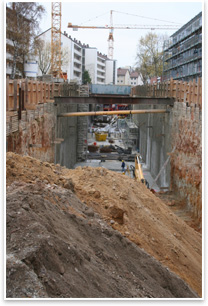AIA’s Rebuild and Renew Plan Puts Building Money into the Public Sector
Stimulus bill funding begins its journey from Washington into the design and construction industry
By Zach Mortice
Associate Editor
 How do you . . . look for business opportunities funded by the American Recovery and Reinvestment Act? How do you . . . look for business opportunities funded by the American Recovery and Reinvestment Act?
Summary: The economic stimulus bill signed into law by President Obama contains funding provisions for public transit, affordable housing, federal sustainability renovations, and more, all advocated for by the AIA’s Rebuild and Renew plan. Given the public and transparent institutional requirements of these government clients, architects are advised to find ways to network with the public and private stakeholders who control the stimulus purse strings.
Mostly lost in the headlines covering the wholly unprecedented $787 billion federal economic stimulus bill signed into law on Feb. 17 is the equally unprecedented provision that invests $8.4 billion into the nation’s public transit infrastructure.
“We’ve never had this kind of money dumped into public transportation at once,” says Ron Stewart, AIA, a principal at the Portland, Ore., headquarters of Zimmer Gunsul Frasca. He’s spearheaded the design and development of Portland’s MAX light rail system since its inception in 1986. “It’s not business as usual. The rules are totally new today from what they were yesterday.”
As the overall design and construction industry is projected to face an 11 percent descent in 2009 with the commercial and residential markets taking the hardest hits, this provision and a handful of others in the stimulus bill are expected to create greater opportunities for architects in the public sector. Such measures were all part of the AIA’s Rebuild and Renew advocacy plan. Though the most prominent of these AIA-supported provisions ($20 billion directed to school construction) was changed in the final version so that states could use the money for a number of purposes, several other parts of it are expected to soothe this intense economic downturn for architects, like funding for Housing and Urban Development (HUD) projects, the General Services Administration (GSA), public transit effort, as well as a handful of bond and business tax measures.
Public housing
Much of the stimulus money in the American Recovery and Reinvestment Act will be spread far and wide, assigned to projects on a state and local level. With HUD projects, pre-existing formulas will determine states’ and localities’ access to money. Depending on the state, legislatures and governors will have different levels of discretion and control over how it’s spent. In many cases, the funds will go to a list of “shovel ready” work that will help agencies complete their project backlogs, although even these projects will still require some design work.
Casius Pealer, AIA, assistant general counsel for real estate and development at the District of Columbia Housing Authority, says this could mean more HUD-funded construction administration jobs for architects. Given the current economic climate for architects, work as energy auditors or inspectors may not be ideal, “but they can be real opportunities for people who otherwise may not have a job and are still in the building industry,” he says.
This infusion of capital into HUD’s coffers could free up their current budget to take on new projects. The agency is getting $10.5 billion, including $2.25 billion for HOME program affordable housing developer grants and $4 billion for HUD’s public housing capital fund, $3 billion of which can be used for new projects. Pealer says this money isn’t likely to reach local projects for two to three months.
As with all government and public agencies, HUD demands a more public and transparent selection and design process from its developers and architects. They’re also more conservative about selecting firms with less applicable building type experience than commercial clients, which means that firms new to public-sector work need to quickly build relationships with agencies and their developers. “You’re not selling your services to the agency that’s getting or giving out the money,” Pealer says. “You’re really selling your services to a developer.”
For HUD- and GSA-funded projects, sustainability expertise is being pushed to the forefront, and will likely sort winners from losers. “That’s a clear priority if not a requirement for all these funds,” Pealer says.
 Public transit Public transit
To be competitive contenders for the $8.4 billion that will fund public transit projects, Stewart says architects need to get to know engineering firms they’ll need to partner with on this kind of work. Also, he suggests finding contacts within local transit agencies to see what projects they’ve got in their backlog. And even if most of this funding is used to pay for projects that have already been designed, Stewart says that this new capital could free up current public transit agency budgets to take on smaller renovations that will employ architects, like bus wash stations and maintenance facilities.
But for this federal money to really have an impact in the short term, Stewart says it’ll have to be coupled with deregulation, “and I know that’s not what people want to talk about in Washington now.”
The strings attached to federal funding can slow a mass transit project down by a year or a year and a half, Stewart says, making the money’s journey from Washington to a local transit agency ponderously slow. Oregon Representative Earl Blumenauer, Hon. AIA, a public transit and sustainability ally of the Institute, has advocated for the streamlining of the funding process and speeding project delivery.
Amtrak, which will receive $850 million of stimulus money, has already assembled a comprehensive list of projects they can’t release until the Federal Railroad Administration signs off on them, according to Amtrak spokesperson Cliff Black. The GSA is receiving $4.5 billion for sustainable renovations for government buildings. They have 45 days from the signing of the bill to release their project list. Other facilities provisions include $6.5 billion for the Department of Defense, $1.5 billion for the National Institutes of Health, and $1.2 billion for the Department of Veterans Affairs. Last week’s Kiplinger Connection in AIArchitect forecasted how the bill’s public infrastructure provisions will be spent on a state-by-state basis. In general, specific stimulus-funded projects have not been publicly revealed yet.
Another AIA Rebuild and Renew-sponsored measure is a small business tax provision that allows for accelerated depreciation for capital expenditures made in 2008. The bill also creates a new category of tax bonds for the construction and renovation of schools. School construction isn’t funded outright with the bill, but there is a $53.6 billion State Stabilization Fund, which will be used to overcome school budget shortfalls. This can include school renovations and repairs.
Think like a politician
The AIA Rebuild and Renew advocacy plan has a shelf life beyond the current crop of emergency stimulus measures in Congress and the White House. “We’ve crafted Rebuild and Renew as a year-long or multi-year-long effort,” says Tom Bergan, the AIA’s manager of federal legislative relations. In the months to come, the AIA will push for inclusion of its school construction provision into any potential new economic stimulus packages, and also to advocate for applicable elements of the plan to be incorporated into other landmark legislation, like the upcoming energy bill, carbon emissions cap and trade bill, and a transportation bill.
Finding your way to this public sector work means forming alliances with various public and private stakeholders, much like the politicians who crafted the legislation. Bergan suggests that architects get in touch with their members of Congress to see which projects they’ve prioritized, as well as state agencies for public housing and transit. In some cases, local government executives—particularly mayors and governors—will have more say on prioritizing projects and assigning money. “Put yourself out there to the best of your ability,” says Bergan, “and try to meet the decision makers and get a sense of the gut-level priorities of their constituents.”
|



